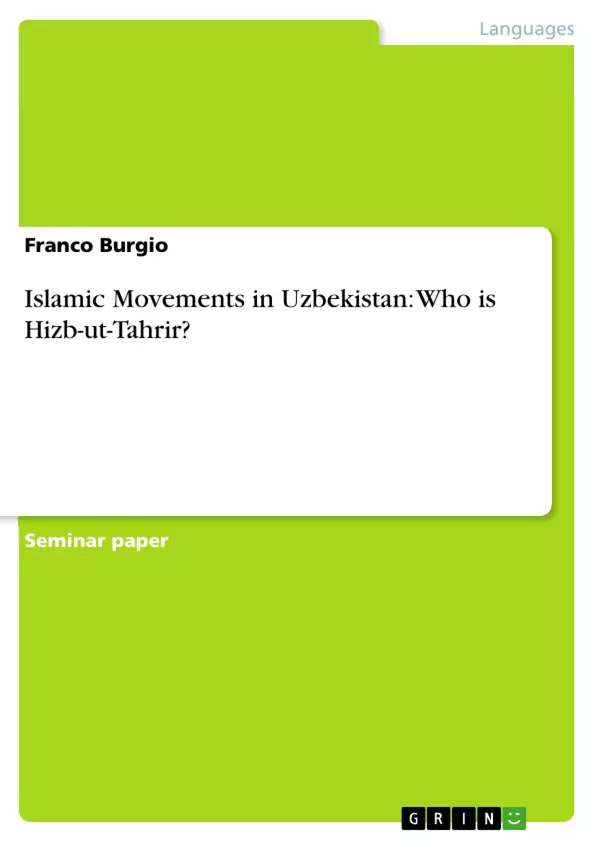Islamic movements have become a crucial political issue in Uzbekistan. Despite having taken some transitional democratic measures (opposition parties were granted legal status, an ombudsman was appointed, etc.), and even though President Karimov had shown an early interest in Western (and in particular European) institutional systems, it seems that over the past five years the democratic process in Uzbekistan has taken a step back to practices inherited from Soviet times. Much of the state’s repressive apparatus and many of the its negative economic policies have been attributed to the need to fight against Islamic extremist. The most prominent Islamic groups in Uzbekistan are the Islamic Movement of Uzbekistan (IMU) and Hizb ut-Tahrir (HuT). After the IMU infrastructure and capacity was destroyed during the U.S.- led military campaign in Afghanistan in 2001 its role in challenging the regime of President Karimov´s regime states has been taken over by the non-violent radical group Hizb ut-Tahrir. Unlike the IMU, the HuT is a true transnational organization that consists of semiindependent branches, only some of which are in Central Asia. In Central Asia, it has been most active in Uzbekistan.
The purpose and the limit of this paper is to give an overview of the historical background, the ideology, the organisational structures and the aims of the HuT. Special attention will be paid to its political methodology and its attitude towards violence, which is essential to understand and assess the role of Islamic movements such as HuT Uzbekistan. Due to the government’s crackdown of the party, state propaganda, conflicting media reports lead by internal and external interest groups and the parties own propaganda agenda it is very difficult to find reliable information about the parties involvement in the region. However, the International Crisis Group (ICG) is the trustworthiest source in this aspect since it has a regular and extended coverage of the area and its political situation with a special focus on the Islamic movements. In addition, they have on the spot teams with direct contact to locals which gives them additional credibility. The papers statements regarding the party’s activities in Uzbekistan are thus mostly based on ICG report about HuT in Central Asia.
Inhaltsverzeichnis (Table of Contents)
- Preface
- Introduction
- The Umma-Concept
- Islamic Movements in Central Asia: Between Nation and Umma
- Roots, Emergence in Uzbekistan and Ideology
- Origins
- Emergence in Uzbekistan
- Introduction to the Ideology of the Liberation Party
- Organization and Political Methodology
- Organization
- Political Methodology
- Attitude Towards Violence
- Conclusion
Zielsetzung und Themenschwerpunkte (Objectives and Key Themes)
This paper provides an overview of the historical background, ideology, organizational structures, and aims of Hizb ut-Tahrir. It focuses on the group's political methodology and attitude towards violence to better understand their role in Uzbekistan. Special attention is given to the group's activities in Uzbekistan, drawing heavily on reports by the International Crisis Group (ICG), a reputable source for information on Central Asian politics.
- The evolution of the Umma concept and its relevance to contemporary Islamic movements
- The historical and ideological roots of Hizb ut-Tahrir
- The organization's structure and political methodology
- Hizb ut-Tahrir's approach to violence and its implications
- The challenges of obtaining reliable information on Hizb ut-Tahrir's activities in Uzbekistan
Zusammenfassung der Kapitel (Chapter Summaries)
- Preface: Introduces the topic by citing a statement from President Karimov on the Akramia movement, which is linked to Hizb ut-Tahrir. Highlights the political significance of Islam and Islamic movements in Uzbekistan and the government's crackdown on dissent.
- Introduction: Discusses the Umma concept, its origins, and its evolution from a trans-regional community to a less significant factor in the post-colonial era.
Schlüsselwörter (Keywords)
Hizb ut-Tahrir, Islam, Islamic movements, Uzbekistan, Central Asia, Umma, political methodology, violence, ideology, organization, International Crisis Group (ICG), President Karimov, Akramia movement.
- Quote paper
- Franco Burgio (Author), 2006, Islamic Movements in Uzbekistan: Who is Hizb-ut-Tahrir?, Munich, GRIN Verlag, https://www.grin.com/document/53959



